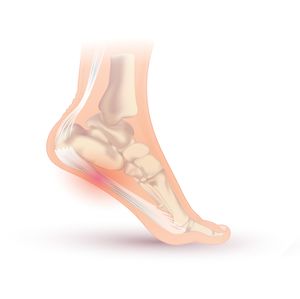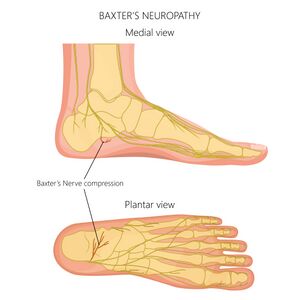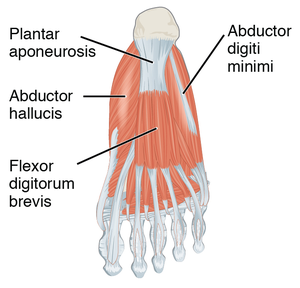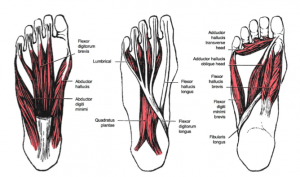Baxter's Nerve Entrapment: Difference between revisions
No edit summary |
No edit summary |
||
| (27 intermediate revisions by 2 users not shown) | |||
| Line 1: | Line 1: | ||
<div class="editorbox"> | |||
'''Original Editor '''- [User:|,Habibu Salisu Badamasi]<br>'''Top Contributors''' - {{Special:Contributors/{{FULLPAGENAME}}}}</div> | |||
== Introduction == | == Introduction == | ||
The most common complaint in the foot and ankle region is heel pain. The most of these problems, however, are related to plantar fasciitis. <ref>Sahoo RK, Peng PW, Sharma SK. Ultrasound-Guided Hydrodissection for Baxter’s Neuropathy Secondary to Plantar Fasciitis: A Case Report. A&A Practice. 2020 Nov 1;14(13):e01339.</ref>Up to 20% of cases of chronic heel pain are caused by Baxter's nerve entrapment. However, it's an often-overlooked source of heel pain.<ref name=":0">Stephen Offutt DP, Patrick DeHeer DP. How to address Baxters nerve entrapment. Podiatry Today. 2004 Nov 3;17(11).</ref> | The most common complaint in the foot and ankle region is [[Plantar Heel Pain|heel pain]]. The most of these problems, however, are related to [[Plantar Fasciitis|plantar fasciitis]]. <ref name=":1">Sahoo RK, Peng PW, Sharma SK. Ultrasound-Guided Hydrodissection for Baxter’s Neuropathy Secondary to Plantar Fasciitis: A Case Report. A&A Practice. 2020 Nov 1;14(13):e01339.</ref> Up to 20% of cases of chronic heel pain are caused by Baxter's nerve entrapment. However, it's an often-overlooked source of heel pain.<ref name=":0">Stephen Offutt DP, Patrick DeHeer DP. How to address Baxters nerve entrapment. Podiatry Today. 2004 Nov 3;17(11).</ref> | ||
[[File:Arch tendonitis.jpg|thumb|300x300px|alt=|center]] | |||
== Clinically Relevant Anatomy == | |||
[[File:BAXTERS NERVE .jpg|thumb]] | |||
Baxter’s nerve also known as inferior calcaneal nerve, is the first branch of the lateral plantar nerve arising within the tarsal tunnel. lateral plantar nerve has sensory components to the calcaneal periosteum, the long plantar ligament and the lateral plantar skin, and motor fibers to the abductor digiti minimi, flexor digitorum brevis and quadratus plantae. The first branch of the lateral plantar nerve originates from the lateral plantar nerve near the bifurcation of the tibial nerve or it may arise from the tibial nerve prior to its bifurcation. It then dives through the superficial fascia at the superior border of the abductor. At this level, the investing fascia of the abductor is thicker laterally because of the reinforcement from the interfascicular ligament in continuity with the medial intermuscular septum. It travels distally between the lateral abductor fascia and the medial edge of the quadratus. When it reaches the lower border of the abductor hallucis, it turns and courses laterally, passing 5.5 mm anterior to the medial calcaneal tuberosity (or spur) and between the quadratus and the underlying flexor brevis until it reaches its distal target of the abductor digiti minimi.<ref name=":0" /> | |||
== | == Etiology == | ||
[[File:1124 Intrinsic Muscles of the Foot b.png|thumb]] | |||
Baxter's nerve is vulnerable to entrapment because of its course, and the most common location is the tight fascia of the abductor hallucis and the medial aspect of the quadrates plantae muscle. However, two point have been proposed as possible entrapment reasons. | |||
# The first is the point where the nerve turns laterally between the medial edge of the quadratus plantae and the thick lateral fascia of the abductor hallucis. | |||
# The second is the point where the nerve courses anterior to the tuberosity and/or spur. An increase in cubic contact of this passage (via a spur or muscle hypertrophy) and/or pronation of the rearfoot/midfoot complex, causing impingement at the nerve’s sharp turn are both possible predisposing conditions.<ref name=":0" /> | |||
[[File:Intrinsic foot muscles.png|thumb|alt=|center]] | |||
== Clinical Presentation == | |||
* Tenderness above the abductor hallucis origin, which can induce laterally radiating discomfort and/or paraesthesia.<ref name=":0" /> | |||
* A sharp, radiating pain worse at night and after physical activity (such as walking).<ref name=":2" /> | |||
* Moderate atrophy of the abductor digiti minimi muscle.<ref name=":3">Prem A, Anand S. Baxter's nerve injury: an often overlooked cause of chronic heel pain: a case report. Arch Clin Exp Orthop. 2023;7:003-004.</ref> | |||
* Pain across the medial calcaneus.<ref name=":3" /> | |||
== | == Examination == | ||
===== Biomechanical exam ===== | |||
Typically, therapists will notice a pronated foot structure during the [[Biomechanical Assessment of Foot and Ankle|biomechanical assessment]].<ref name=":0" /> | |||
===== Special tests ===== | |||
* Tinel's test.<ref name=":2" /> | |||
* Phalen’s test (passive inversion and plantar flexion of the foot).<ref name=":3" /> | |||
* [[Windlass Test|Windlass test]] to rule out [[Plantar Fasciitis]]. | |||
===== Radiography and Bone scan ===== | |||
Osseous pathology can be ruled out with simple radiographs and bone scans.<ref name=":0" /> | |||
===== Serologic testing ===== | |||
Serologic testing may be used to rule out systemic arthropathy.<ref name=":0" /> | |||
== Differential diagnosis == | == Differential diagnosis == | ||
| Line 20: | Line 50: | ||
* Calcaneal stress fractures | * Calcaneal stress fractures | ||
* Periosteal inflammation | * Periosteal inflammation | ||
== Treatment and Management == | |||
===== Medical treatment ===== | |||
NSAIDs and anticonvulsants can aid in symptom relief.<ref name=":2">Allam AE, Chang KV. Plantar Heel Pain. [Updated 2022 Sep 5]. In: StatPearls [Internet]. Treasure Island (FL): StatPearls Publishing; 2023 Jan-. Available from: <nowiki>https://www.ncbi.nlm.nih.gov/books/NBK499868/</nowiki></ref> | |||
===== Conservative treatments ===== | |||
* Kinesio taping or orthotics use at the foot. | |||
* Stretching and strengthening exercises at the foot. | |||
* Cryoablation, radiofrequency, hydrodissection using 5% dextrose, or ultrasound-guided corticosteroid injection.<ref name=":2" /> | |||
===== Surgery ===== | |||
Surgical release/decompression of the nerve.<ref name=":1" /> | |||
{{#ev:youtube|1ZqubXExmc4|}}<ref>Michigan Foot Doctors. BEST Heel Nerve Pain Treatment [Baxters Nerve Entrapment Treatment]. Available from: https://www.youtube.com/watch?v=1ZqubXExmc4 [last assessed 6/11/2021]</ref> | |||
== References == | == References == | ||
<references /> | |||
[[Category:Foot - Conditions]] | |||
Latest revision as of 17:55, 29 June 2023
Top Contributors - Habibu Salisu Badamasi and David Olukayode
Introduction[edit | edit source]
The most common complaint in the foot and ankle region is heel pain. The most of these problems, however, are related to plantar fasciitis. [1] Up to 20% of cases of chronic heel pain are caused by Baxter's nerve entrapment. However, it's an often-overlooked source of heel pain.[2]
Clinically Relevant Anatomy[edit | edit source]
Baxter’s nerve also known as inferior calcaneal nerve, is the first branch of the lateral plantar nerve arising within the tarsal tunnel. lateral plantar nerve has sensory components to the calcaneal periosteum, the long plantar ligament and the lateral plantar skin, and motor fibers to the abductor digiti minimi, flexor digitorum brevis and quadratus plantae. The first branch of the lateral plantar nerve originates from the lateral plantar nerve near the bifurcation of the tibial nerve or it may arise from the tibial nerve prior to its bifurcation. It then dives through the superficial fascia at the superior border of the abductor. At this level, the investing fascia of the abductor is thicker laterally because of the reinforcement from the interfascicular ligament in continuity with the medial intermuscular septum. It travels distally between the lateral abductor fascia and the medial edge of the quadratus. When it reaches the lower border of the abductor hallucis, it turns and courses laterally, passing 5.5 mm anterior to the medial calcaneal tuberosity (or spur) and between the quadratus and the underlying flexor brevis until it reaches its distal target of the abductor digiti minimi.[2]
Etiology[edit | edit source]
Baxter's nerve is vulnerable to entrapment because of its course, and the most common location is the tight fascia of the abductor hallucis and the medial aspect of the quadrates plantae muscle. However, two point have been proposed as possible entrapment reasons.
- The first is the point where the nerve turns laterally between the medial edge of the quadratus plantae and the thick lateral fascia of the abductor hallucis.
- The second is the point where the nerve courses anterior to the tuberosity and/or spur. An increase in cubic contact of this passage (via a spur or muscle hypertrophy) and/or pronation of the rearfoot/midfoot complex, causing impingement at the nerve’s sharp turn are both possible predisposing conditions.[2]
Clinical Presentation[edit | edit source]
- Tenderness above the abductor hallucis origin, which can induce laterally radiating discomfort and/or paraesthesia.[2]
- A sharp, radiating pain worse at night and after physical activity (such as walking).[3]
- Moderate atrophy of the abductor digiti minimi muscle.[4]
- Pain across the medial calcaneus.[4]
Examination[edit | edit source]
Biomechanical exam[edit | edit source]
Typically, therapists will notice a pronated foot structure during the biomechanical assessment.[2]
Special tests[edit | edit source]
- Tinel's test.[3]
- Phalen’s test (passive inversion and plantar flexion of the foot).[4]
- Windlass test to rule out Plantar Fasciitis.
Radiography and Bone scan[edit | edit source]
Osseous pathology can be ruled out with simple radiographs and bone scans.[2]
Serologic testing[edit | edit source]
Serologic testing may be used to rule out systemic arthropathy.[2]
Differential diagnosis[edit | edit source]
- Plantar fasciitis
- Seronegative arthritis-induced inflammation
- Tarsal tunnel syndrome
- Medial calcaneal neuritis
- Heel spurs
- Trauma
- Fat pad atrophy
- Calcaneal stress fractures
- Periosteal inflammation
Treatment and Management[edit | edit source]
Medical treatment[edit | edit source]
NSAIDs and anticonvulsants can aid in symptom relief.[3]
Conservative treatments[edit | edit source]
- Kinesio taping or orthotics use at the foot.
- Stretching and strengthening exercises at the foot.
- Cryoablation, radiofrequency, hydrodissection using 5% dextrose, or ultrasound-guided corticosteroid injection.[3]
Surgery[edit | edit source]
Surgical release/decompression of the nerve.[1]
References[edit | edit source]
- ↑ 1.0 1.1 Sahoo RK, Peng PW, Sharma SK. Ultrasound-Guided Hydrodissection for Baxter’s Neuropathy Secondary to Plantar Fasciitis: A Case Report. A&A Practice. 2020 Nov 1;14(13):e01339.
- ↑ 2.0 2.1 2.2 2.3 2.4 2.5 2.6 Stephen Offutt DP, Patrick DeHeer DP. How to address Baxters nerve entrapment. Podiatry Today. 2004 Nov 3;17(11).
- ↑ 3.0 3.1 3.2 3.3 Allam AE, Chang KV. Plantar Heel Pain. [Updated 2022 Sep 5]. In: StatPearls [Internet]. Treasure Island (FL): StatPearls Publishing; 2023 Jan-. Available from: https://www.ncbi.nlm.nih.gov/books/NBK499868/
- ↑ 4.0 4.1 4.2 Prem A, Anand S. Baxter's nerve injury: an often overlooked cause of chronic heel pain: a case report. Arch Clin Exp Orthop. 2023;7:003-004.
- ↑ Michigan Foot Doctors. BEST Heel Nerve Pain Treatment [Baxters Nerve Entrapment Treatment]. Available from: https://www.youtube.com/watch?v=1ZqubXExmc4 [last assessed 6/11/2021]










